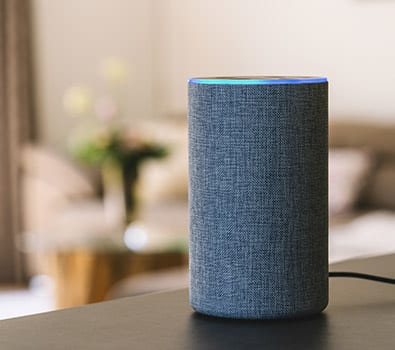The Role of Voice in the Next Generation of the Internet of Things
People aren’t just talking about the IoT — they’re talking to it too. From Siri, Alexa and Google Home to a growing list of chatbots, voice technology presents an opportunity to create an IoT experience that is more flexible, affordable and faster. But will your network connections linking people, devices and business systems keep up?
IoT applications are proliferating and maturing to the point that new innovative ways to collaborate, communicate and interact are tapping into natural language processing. Consumers are enjoying the ease of voice-assistant devices in their homes to control everything from their shopping lists to the energy use of their homes. Meanwhile, industrial applications are freeing the hands of shop-floor workers to keep production running smoothly and undisrupted.

Not all IoT use cases will require voice capabilities, but all network connections and devices should be prepared to accommodate them — even before 5G becomes a reality. By combining Voice over Long-Term Evolution (VoLTE), businesses can extend the user experience and advantages of 4G (and later 5G) through three distinct capabilities:
- Enhanced mobile broadband: Real-world speeds of hundreds of Mbps and beyond offer much more capacity to efficiently support unlimited data and voice.
- Ultra-reliable low latency or mission-critical services: New opportunities such as autonomous vehicle and vehicle-to-everything (V2X) applications become possible when data is transmitted and service is accessible without delay.
- Low power consumption: Addressing this ever-growing need for power efficiency enables use cases for massive volumes of IoT communications and data through low-power, wide-area wireless technology.
The IoT is no longer just about capturing data from one endpoint to another — now it’s about integrating the most natural way people work to drive higher employee engagement, business productivity and process control. In this white paper, we’ll explore the ways VoLTE can advance your IoT capabilities, review use cases and discuss the best approach to implementing VoLTE to secure process relevance, lower costs and improve the user experience.
Why VoLTE Should Be at the Top of Your IoT Wish List
As interest in voice-enabled use cases for the IoT grows, businesses are considering a long-term plan for simplifying their mobile networks to drive progress until 5G arrives in 2020. Existing 2G and 3G networks are being leveraged and later repurposed for the more efficient 4G spectrum.
The theory behind the concept may be correct; however, there is a better way to gain the capacity and direct connection needed to support voice capabilities. VoLTE enables you to facilitate high-quality voice services today and later add fresh, unique and value-differentiating services that appeal to evolving changes in the workforce, customer base and marketplace. More importantly, the IoT system will not have to jump from one network to another to deliver much-needed capabilities.
The case for VoLTE is so compelling that the latest research from the GSMA revealed that 165 operators representing 73 countries are investing the related deployments, trials and studies.1 With hundreds of smartphone models supporting VoLTE, commercial and industrial momentum is driven by the potential for network efficiency, low power consumption and data-streaming continuity.
Voice Is the Future of IoT — and It’s Here
As much as 5G promises dual support of data and voice, you do not have the luxury to wait until 2020. Market domination is currently achieved by actively adopting and leveraging the latest technologies and innovations. And right now, there is tremendous pressure to compete with over-the-top messaging, video, two-way human interactions and social networks.
Your business needs VoLTE to not only move voice to the more spectrally efficient 5G network but also scale and integrate services with existing underlying technologies. Doing so allows organizations to unlock a wave of unified communications services that go beyond shaving a few pennies off their operational costs.

According to Ovum, 53% of the total cellular subscriptions worldwide will be VoLTE-enabled connections by 2021.2
How Security Initiatives Can Kick-Start Your VoLTE Adoption
At first glance, investments in VoLTE may not appear to be an urgent decision when existing 2G, 3G or 4G connections are still working well. However, the exposed vulnerabilities of these networks may make executives think twice as a rising number of significant breaches drain millions in revenue from businesses worldwide.
This line of thinking is critical as customers demand assurance that their data and assets are handled securely. Legacy systems that leverage voice-enabled capabilities transfer this data through internet protocol (IP) packets. This approach can be unreliable since delivery, reliability, flow control and error recovery are not guaranteed. As a result, the chosen network may experience unpredictable delays, packet loss and out-of-order packet delivery, which prove disruptive for IoT devices, alarms and data exchange as well as an opportunity for malicious actors to hack the system.
Guidance from Groupe Spéciale Mobile Association (GSMA) and innovations supported by telecommunications providers, such as Verizon and AT&T, are making VolTE an increasingly secure IoT connectivity option than traditional voice. In the future, we may see VoLTE become standard for IoT business cases such as pinpointing asset locations, monitoring patient health and capturing point-of-sale transactions as it embodies three fundamental advantages3:
- Network scalability: With single technology that is not undermined by network fragmentation and diversity, VoLTE can support IoT landscapes with over six billion connections across all devices and systems.
- Less complexity: As a consistent environment for delivering voice services, VoLTE underpins how voice, short message (SMS) and rich communication (RCS) services will be redefined for end-to-end calling structures.
- Support for interconnectivity and roaming: Lower complexity allows seamless interconnectivity and roaming between every device and network.
Steffen Sorrell, the principal analyst for Juniper Research states, “The interconnected nature of the IoT means that even innocuous devices like the connected fridge can become a threat. Vendors see that risk as low, while little has been done from a regulatory perspective to protect consumers.”4
Telit: Your Guide to VoLTE Standardization and Deployment
With Telit, you can rest assured that investments in your IoT assets and connections will keep working not just today and not just until 5G becomes operational — but for the next 10-15 years.
Our VoLTE-capable modules are designed to offer the efficiency and security that businesses need to deliver high-quality customer experiences, keep data exchange undisrupted, and secure data and machine assets. Integrators and providers now have more options to lower costs, increase security and extend product life cycles — thanks to Telit’s VoLTE-certified modules.
About Telit
Telit is a global leader in Internet of Things (IoT) enablement with an extensive portfolio of modules, global connectivity services, software and platforms that empower millions of connected devices by delivering secure, integrated, end-to-end IoT solutions for many of the world’s largest brands. With over 20 years of IoT innovation experience, Telit is trusted by thousands of direct and indirect customers worldwide and enables enterprises, OEMs, system integrators and service providers across all industries to simplify, connect and manage IoT at any scale.

Telit’s portfolio of modules includes the market’s best suited for a variety of applications. By offering a variety of form factors to choose from, we make it easy to keep pace with the evolution of wireless standards and with your product’s geographic reach growth without costly hardware upgrades or design revisions.
Our cellular modules — including Cat 1, LTE-M and NB-IoT — are compact, highly reliable and designed to support a wide range of frequency bands. They also support the latest 3GPP features, minimum power consumption and extended coverage.
Endnotes
1. “The Mobile Economy 2018,” GSMA, 2018.
2. “Global VoLTE Connections to Grow By 3.33bn, Predicts Ovum,” Capacity Media, 2017.
3. “Realising Revenue Potential with Voice Over LTE,” GSMA, 2018.
4. “IoT Security Spend to Reach $6 Billion by 2023, Growing 300% from 2018,” Juniper Research, July 11, 2018.


